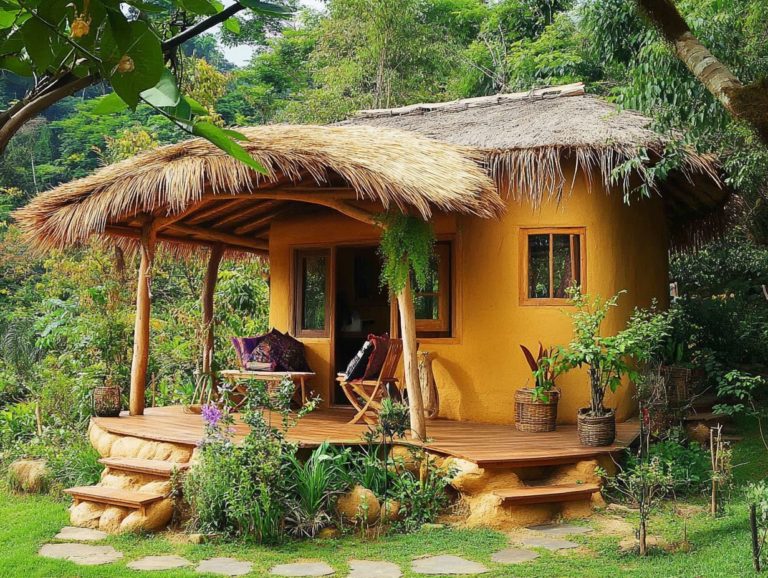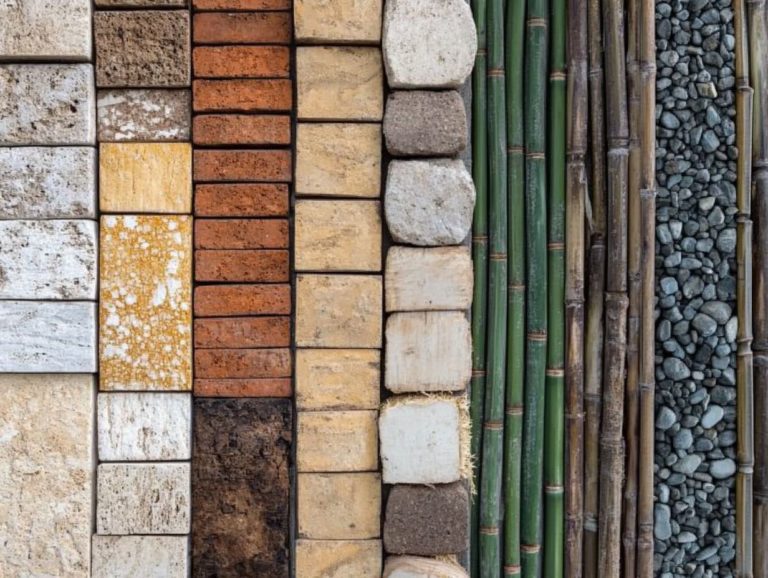The Role of Sustainability in Tiny House Construction
As the tiny house movement gains traction, sustainability takes center stage, transforming your perspective on living spaces.
This article delves into the essential role of eco-friendly practices in tiny house construction, emphasizing both their environmental advantages and potential cost savings.
From selecting sustainable materials to crafting energy-efficient layouts, you’ll discover strategies that foster long-term sustainability.
We ll tackle the challenges you may encounter as a homeowner and highlight the innovative housing solutions that are shaping a greener future in tiny living.
Embark on this journey with us as we explore the intriguing intersection of sustainability and tiny home design.
Contents
- Key Takeaways:
- The Importance of Sustainability in Tiny House Construction
- Cost Savings and Long-Term Sustainability
- Sustainable Materials and Design Strategies for Tiny Houses
- Challenges and Solutions for Sustainable Tiny House Construction
- The Future of Sustainable Tiny Houses
- Potential for Growth and Innovation
- Frequently Asked Questions
- What is sustainability and why is it important in tiny house construction?
- How can sustainability be incorporated into the design of a tiny house?
- What are some eco-friendly materials that can be used in tiny house construction?
- How does sustainable construction contribute to the overall sustainability of a tiny house?
- What are the benefits of incorporating sustainability into tiny house construction?
- How can individuals ensure sustainability in the maintenance and operation of their tiny house?
Key Takeaways:

- Sustainability is a crucial factor in tiny house construction, with a focus on minimizing environmental impact and long-term homeowner savings.
- Choosing eco-friendly materials and designing for energy efficiency are key strategies for creating sustainable tiny homes.
- Despite challenges such as limited space and building codes, the future of sustainable tiny houses looks bright with potential for growth and flexibility and mobility.
Defining the Concept and Its Popularity
Sustainable tiny homes have become a captivating lifestyle choice for individuals and families seeking innovative housing solutions. This movement emphasizes affordability and environmental consciousness.
As momentum builds, many are drawn to minimalist living, viewing it as a pathway to financial freedom while reducing their carbon footprint. Organizations like the Tiny House Industry Association are backing this trend, which has flourished in cities like Detroit, Michigan, and Denver, Colorado.
The appeal of sustainable tiny homes lies not just in their distinctive design, but also in their ability to address pressing housing market issues. This is especially true for those struggling with high living expenses. Exploring options like using earthbags for sustainable tiny house building can further enhance their eco-friendly benefits.
Influential advocates like Zack Giffin promote this lifestyle, encouraging you to rethink traditional housing norms. Research institutions, including Harvard University, offer valuable insights into the advantages of tiny living, highlighting its sustainability and enhancement of quality of life. Additionally, using recycled materials in tiny house designs can further support these principles.
The United Nations recognizes tiny homes as a potential remedy for global housing crises, paving the way for broader acceptance and integration into mainstream society.
The Importance of Sustainability in Tiny House Construction
Sustainability holds paramount importance in tiny house construction. It enables you to significantly reduce your environmental footprint while enhancing energy efficiency and overall quality of life.
Embracing eco-friendly materials and innovative design features, tiny homes lower energy expenses and explore off-grid living (living independently of utility services). This makes them an exceptional choice for those prioritizing environmental consciousness.
Environmental Impact and Benefits
The environmental impact of sustainable tiny homes is significantly lower than that of traditional houses, thanks to their smaller size and efficient use of eco-friendly materials. This reduced carbon footprint not only benefits the planet but also encourages a more sustainable lifestyle.
By consuming less energy for heating and cooling, these compact dwellings can dramatically lower your utility bills and minimize greenhouse gas emissions.
Many tiny homes are constructed with recycled or repurposed materials, further reducing waste and promoting resource conservation.
Homeowners are excited to embrace sustainable practices like composting and rainwater harvesting. These actions are your chance to support the environment while connecting deeply to nature!
This holistic approach encourages you to significantly reduce overall consumption, compelling you to prioritize experiences over possessions and cultivate a more mindful way of living.
Cost Savings and Long-Term Sustainability
Exploring sustainable tiny homes offers impressive cost savings in both initial investment and ongoing expenses. You can enjoy lower energy costs and reduced maintenance requirements, making tiny house living a financially savvy choice for those who prioritize long-term sustainability.
Choosing a smaller space often means lower mortgage or rent payments. This frees up funds for more meaningful experiences or investments that truly resonate with you. Energy-efficient designs and appliances in tiny homes lead to significantly reduced utility bills, showing your commitment to sustainable living. With less space to manage, maintenance expenses decline, relieving you from the financial burden of larger properties.
This lifestyle paves the way for financial freedom while fostering a more mindful approach to consumption and resource use.
Sustainable Materials and Design Strategies for Tiny Houses

Selecting sustainable materials and employing intelligent design strategies are crucial for building environmentally friendly tiny houses that reflect the principles of the tiny house movement.
By choosing eco-friendly materials, you boost energy efficiency and create customization options that cater to your distinct lifestyle needs.
Choosing Eco-Friendly Materials
Using eco-friendly materials is essential in constructing sustainable tiny homes, impacting both the environment and the long-term durability of your structure.
Selecting wood alternatives, like bamboo or reclaimed lumber, significantly reduces deforestation and supports sustainable forestry practices. Incorporating recycled products such as glass and metal enhances the aesthetic appeal of your home while minimizing landfill waste.
Opting for non-toxic finishes eliminates harmful chemicals that could compromise indoor air quality, fostering a healthier living environment for you and your loved ones. These materials not only promote sustainability but also support an eco-conscious lifestyle and reduce your carbon footprint.
Designing for Energy Efficiency
Designing for energy efficiency is fundamental in sustainable tiny homes, where smart design features minimize energy consumption while maximizing comfort. Using strategies like passive solar design which utilizes sunlight for heating and energy-efficient appliances significantly enhances your off-grid living experience, allowing you to harness renewable solar energy.
Carefully orienting your home captures optimal sunlight, letting natural light illuminate living spaces and reducing reliance on artificial lighting.
Using insulated windows and thermal mass materials improves temperature regulation, making it easier to maintain comfort without excessive heating or cooling. Incorporating energy-efficient appliances, like programmable thermostats and Energy Star-rated refrigerators, ensures that every watt is utilized wisely, lowering your energy footprint dramatically.
These design elements promote an environmentally friendly lifestyle and create a balance between comfort and sustainability, allowing you to thrive in your off-grid sanctuary.
Challenges and Solutions for Sustainable Tiny House Construction
While the benefits of sustainable tiny homes are many, you ll face challenges during construction and implementation, especially with building codes and optimizing limited space and resources.
Addressing these obstacles requires innovative solutions that prioritize both sustainability and practicality, ensuring the tiny home movement flourishes.
Explore the world of sustainable tiny homes today and take the first step toward a more eco-friendly lifestyle!
Overcoming Limited Space and Resources
Overcoming the constraints of space and resources is crucial for your journey into successful sustainable tiny home construction. You ll need to embrace creative design ideas that maximize functionality. Comfort should never be compromised.
Consider using multi-functional furniture and flexible designs. These designs can be adjusted for different uses, creating a spacious yet efficient living environment.
By incorporating elements like foldable tables, sofa beds, and nested seating, you can seamlessly transition your space to accommodate various needs throughout the day. Vertical storage solutions, such as wall-mounted shelves and ceiling-hung organizers, will save precious floor space and help you maintain an organized and visually appealing atmosphere.
These design strategies enhance usability and contribute to a more enjoyable living experience. They help you reduce clutter and increase accessibility. Implementing eco-friendly practices shows a commitment to sustainability, ensuring that your limited resources are utilized effectively while fostering a comfortable and inviting home environment.
Addressing Building Codes and Regulations

Navigating building codes and regulations presents a significant challenge for anyone passionate about sustainable tiny homes. These laws often overlook the unique characteristics of tiny living, making advocacy for innovative housing solutions crucial.
For instance, many tiny home enthusiasts face hurdles related to minimum square footage requirements, which dictate the smallest size a home can be built. Strict zoning laws often limit where these homes can be situated, compelling potential owners to rethink their options entirely.
By rallying community support and engaging with policymakers, advocates like you can drive code adjustments that recognize the benefits of compact living. Embracing innovative structural designs, such as modular components or collapsible setups, can help bridge the gap between sustainability and compliance. This ensures that tiny homes meet regulations and establish new benchmarks for environmentally responsible housing. To learn more about the impact of tiny homes, check out the environmental benefits of tiny houses.
The Future of Sustainable Tiny Houses
The future of sustainable tiny houses presents an exciting opportunity for you. An increasing demand for affordable housing and innovative solutions resonates with the core values of the tiny house movement.
As awareness of sustainability continues to rise, you ll find that the potential for growth in this sector is substantial. It encourages community engagement and fosters collaboration among enthusiasts and developers alike.
Potential for Growth and Innovation
Imagine the endless possibilities for growth and innovation in sustainable tiny homes! You have numerous opportunities for new designs, technologies, and community development initiatives that can transform your approach to housing.
As the tiny house movement gains momentum, innovative solutions are emerging to tackle the challenges faced by aspiring homeowners. Advancements in eco-friendly building materials, like recycled steel and sustainable wood alternatives, are paving the way for construction that respects the environment. Additionally, understanding the role of textiles in tiny house design can enhance functionality and aesthetics.
Design technologies such as 3D modeling and modular construction techniques allow for a more efficient use of space and resources. This ensures that every square foot counts.
Community-focused initiatives, including co-housing projects and shared resources, cultivate a sense of belonging among residents. They also enhance sustainability through collective efforts. Together, these innovations elevate the appeal of tiny living, drawing in a diverse array of individuals and families eager for economical, low-impact lifestyle choices and exploring top sustainable building techniques for tiny houses.
Frequently Asked Questions
What is sustainability and why is it important in tiny house construction?
Sustainability is the ability to meet present needs without compromising future generations. In tiny house construction, it promotes environmental responsibility and resource efficiency.
How can sustainability be incorporated into the design of a tiny house?

Designing a tiny house sustainably is exciting! You can use renewable materials, energy-efficient systems, and maximize natural light and ventilation.
A well-insulated space minimizes its effect on the environment.
What are some eco-friendly materials that can be used in tiny house construction?
Consider using reclaimed wood, bamboo, cork, recycled plastic, or straw bales. These materials are renewable and have a low effect on the environment.
How does sustainable construction contribute to the overall sustainability of a tiny house?
Sustainable construction uses energy-efficient systems and materials. This not only lowers the house’s environmental impact but also saves money in the long run.
What are the benefits of incorporating sustainability into tiny house construction?
Embracing sustainability offers exciting benefits! These include lower energy costs, better indoor air quality, and a lower environmental footprint.
It can also boost the resale value and promote a responsible lifestyle.
How can individuals ensure sustainability in the maintenance and operation of their tiny house?
To maintain sustainability, use renewable energy, conserve water, and manage waste responsibly. Regular upkeep and energy-efficient habits prolong the house’s life and further reduce its environmental impact.






